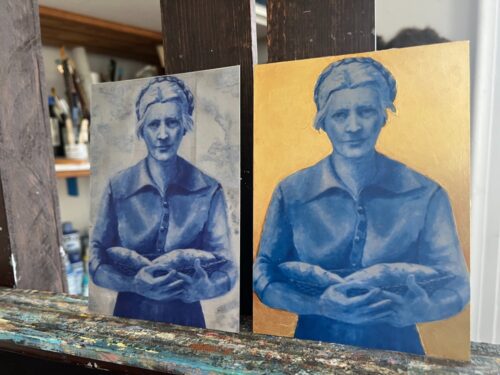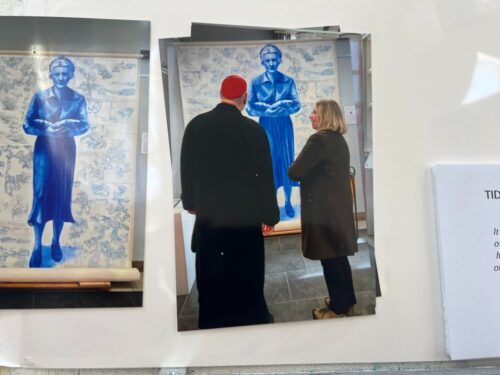
THE BRONX — As the sainthood cause for Dorothy Day’s advances, raising awareness of the legacy of the Catholic social activist is crucial. A New York-based artist is part of that effort, working diligently to spread the word about Day’s life and works in the best way she knows how — through her art.
Kristi Pfister spends her days in her home studio on Staten Island, painting and drawing Dorothy Day, a woman she considers a “21st-century saint for our future.” The results of that work can be seen on display at Manhattan College, which is hosting an exhibit titled “Radical Action: Tracing Dorothy Day.”
“Maybe I’m not going to lead a protest, but this is another form of how I’m certainly championing this amazing woman,” she said.
The exhibit, open to all in the O’Malley Library Gallery, is filled with Pfister’s fabric columns, mosaics, and mixed media work. With her art, she hopes to share the social activist’s message and portray the selflessness of her acts.
Pfister’s connection to Day began in 2005 when she and a group of public artists who were part of the Art Makers collective created a mural on the wall of a building in Bedford-Stuyvesant aptly titled “When Women Pursue Justice.” Assigned to paint the activist, Pfister delved into her teachings and read several of her books.
“She has this kind of devoutness, but also this independence and this incredible intelligence that I think really is a role model for women,” Pfister said.
Since then, she has expressed Day’s message in many projects. Through the series of mosaics at her exhibit, she recreates the imagery of her hands and her signature long hair braid. Pfister’s work compares Day to a Caryatid statue, like the statues of women found at the Acropolis in Greece, standing tall and doing her devoted work without complaint.

In many ways, she says, her exhibit is public art: accessible to all, close to a train station and available to the community whenever. This aspect of the work is necessary, because it is what Day would have wanted.
“I feel a connection to her through her work and through my work,” Pfister said. “I think it’s important that people know about her.”
Born in Brooklyn Heights, Dorothy Day moved to the South Shore on Staten Island in 1924 and was moved by the borough’s natural beauty, particularly its water. As such, one of Pfister’s artworks is a mosaic piece depicting the ocean.
The borough holds significance in Day’s life. She converted to Catholicism while living there with her common-law husband, and she and her daughter were both baptized in the island’s Tottenville neighborhood.
Day founded the Catholic Worker Movement, an initiative designed to provide services to those in need through promoting justice and charity. In 1997, Cardinal John O’Connor, then archbishop of New York, opened the cause for Day’s canonization, which drew controversy, in part because, some critics said, she had an abortion before she converted to Catholicism.
However, Pfister said, “I think she’d be a very modern saint. And I hope it comes to fruition in our lifetime,” she said.

The Catholic Worker Movement returned to Staten Island, the organization announced in February, and is currently fundraising to open a community later this year.
Their shared connection to Staten Island furthered Pfister’s interest, and while she is not Catholic, her husband is, and met Dorothy Day when he was a child.
“She’s not only beloved by the Catholic faith, hopefully for her future sainthood, but young people are drawn to her. She has broad appeal for walking the walk,” Pfister said.
Open since the beginning of the school year, “Radical Action: Tracing Dorothy Day” was visited by Cardinal Timothy Dolan of New York when Manhattan College commemorated the opening of the Dorothy Day Center.

Dorothy Day helped feed the hungry, tried to give workers everywhere the dignity we all deserve, and voiced antiwar sentiments that remain valid today. She was a radical in action, in and out of jail and the church.
Can somebody say Amen?